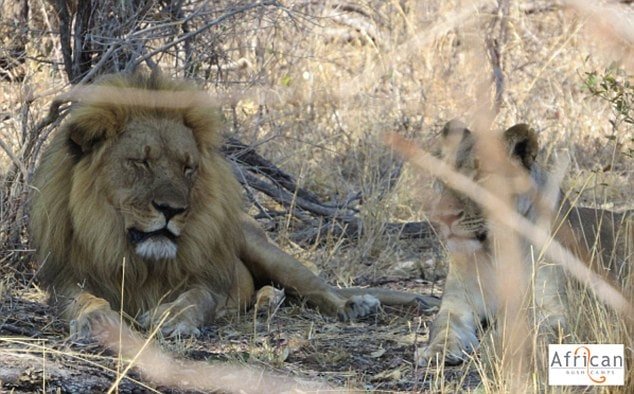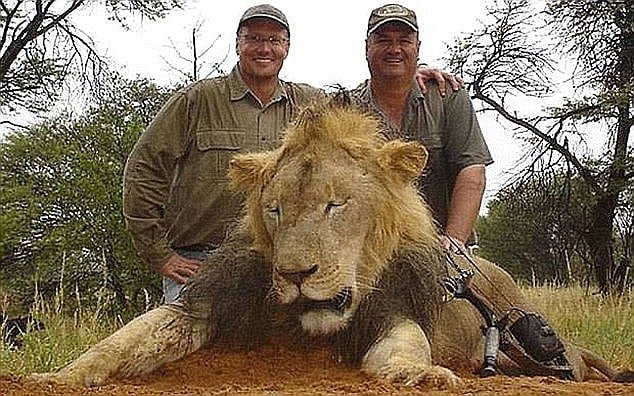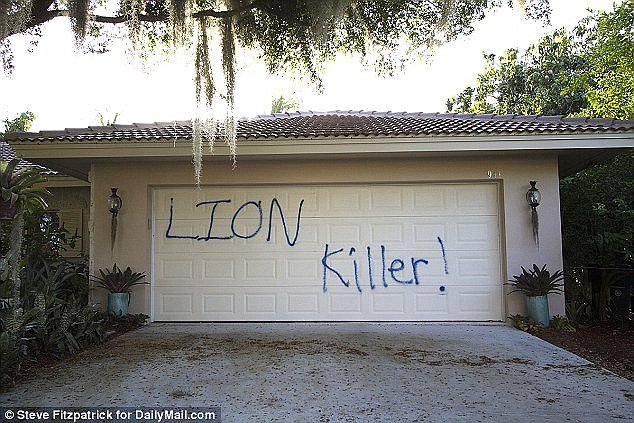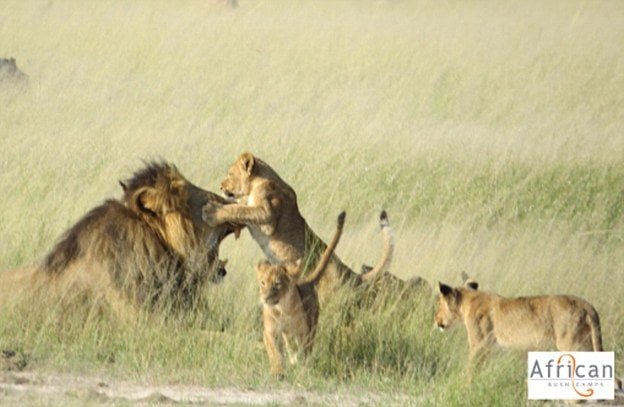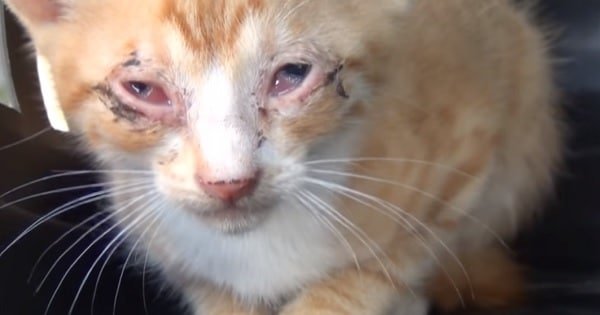The brother of Cecil the Lion who was shot as a trophy by an American dentist prompting international outrage has been found dead, His lifeless body was discovered underneath a bush in the safari park where last year’s controversial hunt took place.
Jericho is believed to have died of natural causes in Zimbabwe’s Hwange National Park following reports that he was looking extremely frail as of late.
A postmortem will indeed be carried on the cat whose death today prompted a massive outpouring of grief by the online community – notably since Cecil’s death last year.

Jericho is seen relaxing by an ant hill in Hwange National Park, Zimbabwe, where he was found dead by researchers
Jericho’s body was discovered by researcher Jane Hunt who is from Hwange Lion Research on Saturday at 5 pm during a routine monitoring of Hwange’s collard lion population.
Jericho had been collared six months ago and was closely monitored. Hwange Park’s Caroline Washaya-Moyo told MailOnline: ‘Although Ms. Hunt and her team did not see any sign of the cat being shot or snared, the fact that he had such a high profile following the death of Cecil – and perhaps would be coveted by hunters – prompted them to order an investigation into his death.
Samples were taken from the carcass, which was severely decayed and sent for testing.’

Jericho (right), the brother of Cecil the Lion (left), has been found dead under a bush in the safari park where last year’s controversial hunt took place
Jericho’s head was also removed from his body and was transported back to Hwange’s main camp for safe keeping – a lion’s is worth a great deal of money to trophy hunters, many of whom travel to Zimbabwe all the way from America and Europe and pay high sums for the head of a wild animal to hang on their walls as trophies.
The rest of Jericho’s remains were buried right at the site in a deep hole to prevent him being devoured by scavengers.
A detailed report which was released by Hwange’s lion researchers reveals that Jericho’s dead body was found under a shaded ‘rest site’ frequently used by animals to shelter from the harsh African sun.
’The way in which the carcass was positioned when found suggest the lion died while resting at this point,’ Mrs. Wahaya-Moyo stated.
Southern Africa is currently experiencing a severe drought at the moment with many wild animals struggling to find enough food and water to sustain themselves.
Poignant footage of Jericho, who was 12 years old, repeatedly calling for Cecil, following his killing in June last year, was shared literally hundreds of time on social media as tributes flooded in from all over the world.
Originally Cecil and Jericho’s were the greatest rivals, who actually fought over females and territory.
After some years, during which Jericho lost hunting partners to hunters, he and legendary Cecil formed one of the most effective bonds Hwange had ever seen.
Walter Palmer, from Minnesota, paid $55,000 to hunt and shoot the majestic Cecil, who was easily recognizable by his black mane and the biggest tourist draw card at the Hwange National Park in Zimbabwe.
The magnificent cat wore a collar and was a key part of a costly research project which is monitored by Oxford University.
The shamed dentist was forced into hiding for several weeks after receiving death threats following his shooting of Cecil which prompted an international outcry.
However, the hapless hunter only managed to wound the lion and Cecil then spent a further 11 hours in total agony before he was tracked by a professional marksman and put out of his misery.
Cecil’s corpse was later beheaded, skinned and salted, but the ‘trophies’ that Palmer had hoped to ship back to his home were later confiscated by the Zimbabwean authorities and the hunter leading Palmer on that fateful day was officially charged.
Many countries have since changed their laws on importing animal trophy killings in the wake of the outrage.
The Hwange Lion Research Project, which announced Jericho’s death on Facebook, explained that his carcass was discovered on Saturday and had been dead for a few days.
Given how close Jericho had come to death on occasions – losing so many allies and surviving being caught by the neck in a snare – the fact that he lived to be 12 at all was remarkable, researchers stated.
Jericho was tracked regularly following the death of Cecil amid incorrect reports that he too had been slaughtered by poachers. Despite the worst fears that he would not survive, nor the two prides he had once shared with his distinctive partner, he appeared to fare well for some time.
He was reported to ‘be looking ill’ during a game count which was held in September of all Hwange’s wild animals and had been alone with absolutely no support to hunt or survive following the loss of Cecil.
More than 200,000 lions roamed Africa at one time.
Today only 25,000 survived.


